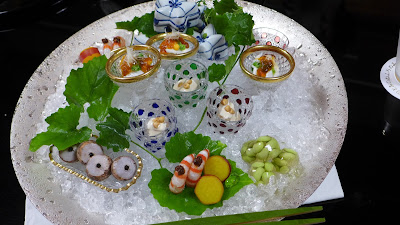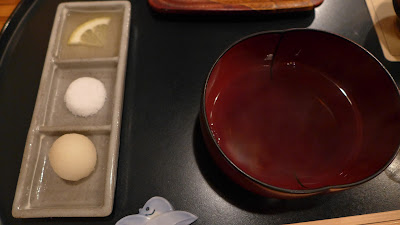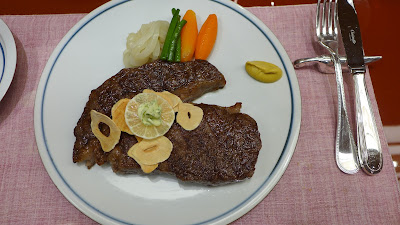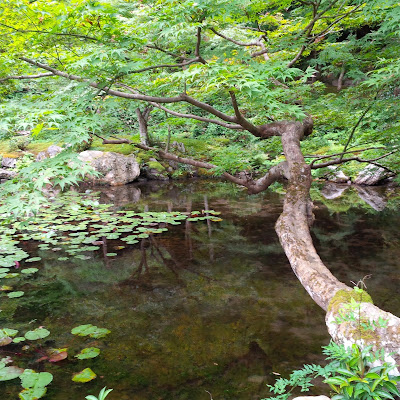Eating in Japan, is not only about the food, but also about the experience. For me, there is nowhere in the world that the eating "experience" can compare and provide this singular enjoyment. It is a very big advantage to eat with a Japanese friend who shares the same passions about good food.
Kaiseki is a traditional multi-course Japanese dinner that originated in Kyoto. The term refers to the collection of skills and techniques that lead to meals that are analogous to European haute cuisine. Typically, a set menu of highly selected food is served in small, carefully chosen presentation dishes on an individual tray for each guest. The typical beverage served is a high quality cold saki, ginjo or daiginjo quality, and/or good beer.
Kaiseki is a traditional multi-course Japanese dinner that originated in Kyoto. The term refers to the collection of skills and techniques that lead to meals that are analogous to European haute cuisine. Typically, a set menu of highly selected food is served in small, carefully chosen presentation dishes on an individual tray for each guest. The typical beverage served is a high quality cold saki, ginjo or daiginjo quality, and/or good beer.
Kaiseki is an art form expressed by the chef, that balances taste, texture, food appearance and colours, with carefully chosen, hand crafted dishes, drinking cups and sometimes even glasses, into a artful composition that reflects the season. Only pristinely fresh, seasonal, often local, ingredients are prepared. Dishes are beautifully arranged and garnished, often with real leaves and flowers, as well as edible garnishes designed to resemble natural plants and fishes.
Kaiseki restaurants are typically very serious in their attention to the smallest detail of presentation, hand gestures, body movements of serving staff and the deferring manner expressed to all patrons. The exquisite formality, precision of each ritualized serving movement and the deferring manner of all staff are very important elements of the ambiance and eating experience of these restaurants.
Arashiyama Kitcho
Arashiyama Kitcho is a Michelin 3*** restaurant that specializes in kaiseki cuisine. This very traditionally elegant restaurant has been around for over 80 years.
To begin we were served with iced glasses of refreshing rosehip juice, presented in a Japanese cut crystal.
The mound of ice served as a tray, chopsticks embedded, topped by a very hot stone in a ceramic bowl, fresh abalone slices topped with a piece of sweet pepper accompanied by abalone liver sauce, vinegar and a mound of finely grated ginger.
My saki cup is to the right, filled with the most delightful daiginjo saki, having layers of delicate flavours. I picked up a slice of the raw abalone and placed it on the hot stone to be grilled.
Enjoying the abalone. The serving staff at these restaurants are always dressed in formal traditional clothing.
Seasonal hamo (conger eel), only available in summer, in a clear broth made from the eel.
Incredibly fresh, sweet sea bass sashimi with wasabi, thinly sliced radish, wasabi, finely grated black mushroom topped with gold leaf, accompanied by soy sauce.
Lightly grilled, but sashimi style, Japanese whelk and toro grade tuna, accompanied by wasabi, a small mound of finely grated ginger, a small bowl of sesame seeds and soy sauce.
In the garden, the outdoor charcoal grill is used to cook our ayu (sweetfish) to come.
The presentation of the grilled ayu (sweetfish), a seasonal fish only available 3 months of the year. This species is typically fished in the rivers and coastal waters of northern Japan, in the region of Hokkaido.
The sweetfish with the head, tail and vertebrae removed, served with a mild watercress puree sauce.
Second serving of sweetfish.
House made tofu with Hokkaido sea urchin, all topped with wasabi jelly and julienned nori.
The sweetfish head, vertebrae and tail, deep fried to crisp perfection, all eaten, head to tail.
A presentation with some of the dishes to come.
Accompanying the fried sweetfish head, tail and vertebrae, some more small dishes: lightly steamed shrimp with miso paste, steamed crab with vinegar sauce, steamed stock of taro with sesame sauce, deep fried and candied goby fish, steamed taro and sweet potato and jellied soy beans.
Deep fried head of the shrimp, to be eaten in it's entirety, at 12 o'clock in this photo.
Steamed and grilled eggplant, steamed pumpkin, steamed okra and steamed sweet pepper, all topped with shaved bonito.
Grilled Kyoto beef with cucumber, grated ginger accompanied by a vinegar sauce.
Steamed rice with sweet corn kernels topped by grilled eel (on the left). Salt pickled eggplant, salt pickled cucumber and stewed kombu kelp (on the right).
Sweet adzuki bean jelly.
Green tea ice cream, made from macha tea over red bean (adzuki) paste. Truly intense and delicious.
Green tea sorbet.
Two kinds of walnuts, one covered with powdered sugar abd the other with seet potato powder (no photo).
A typical room, slightly larger than our own.
Being welcomed in the garden by the owner of the restaurant.
Mishima Tei
Mishima Tei is a sukiyaki resto located in an old building in the Nishiki Market. It was founded in 1873 and is quite renown as a restaurant for special occasions. Entering the restaurant, one removes their shoes and goes upstairs to a tatami mat covered room to sit on chairs and eat at tables (not the floor). The menu offers choices of sukiyaki style or oil style (oil yaki). We chose oil style, beef grilled in a pan.
Specially selected seasonal vegetables, in a pan with a lump of prime kyoto beef fat, to be grilled in the pan for it's oil.
More seasonal veg to be grilled in the pan.
Rice with condiments: grated daikon in soy sauce and pickled veg.
The prime, aged Kyoto beef. Notice the exceptional marbling!
The beef in the pan for grilling. Beef boys rating (taste, texture, juiciness , rated out of 10), a great 9/10/9......superb!
Yoshikawa
The signature style of tempura here uses a very light batter, which also barely coats the food to be cooked. The oil was so fresh that it was crystal clear when the cooking began. Every time the chef was ready to put something in the oil he would first put a few drops of batter in the oil to test the temperature.
Zensai course: saba (mackerel) sushi, winter cherry, pate of wintermelon, soy bean paste and duck (denga-ku style....skewered).
Mokuzuke course: chutoro grade tuna and sea bream sashimi accompanied by grated wasabi, sea salt and soy sauce.
Tiger shrimp tempura, half portion, I hungrily ate the other half before remembering to take a photo. Shrimp is eaten crispy head and crispy tail. The shrimp was extremely fresh and sweet.
Kamo (eggplant).
Whitefish.
Mushroom.
Hamo (seasonal conger eel) and salt mixed with pepper.
Shiizakana course: fig, fried and simmered eggplant, koimo (a small variety of potato) green beans and yam topped with a highly complementary sesame and soybean paste sauce.
More tempura: very crunchy lotus root.
Asparagus.
Gohan (pickled courses): grated Japanese pepper and dried baby sardines (each about a cm long) (ate those before the photo was taken) and pickled cucumber, to be eaten with the next course, mixed tempura, chopped shrimp and rice.
Miso soup served (with the above and below) with the mixed tempura rice.
Kakiage course: tempura of shrimp, enoki mushrooms and parsley, rice.
Yutaka
Yutaka is a Kyoto steak house of renown. One may only visit if accompanied by a Japanese. There is only counter seating for 10. The wine glassware is Reidel and the tableware, Christoffle. This is a very serious resto, but the atmosphere, although restrained, is not formal.
Cooking a filet steak of local Kyoto black beef. Beef is cooked for a long time at low temperatures, producing tender, melt in your mouth steak, and only seared at the last minute.
Local, Kyoto beef carpaccio. Like eating a great butter because of the sweetness and mouthfeel. The condiments were soy sauce, chopped scallions and finely grated garlic.
My 250 gm sirloin cooked rare, topped with thinly sliced garlic dried and browned in oven with veg and a dab of mustard.
The presentation of the filet.
The conclusion of the meal, garlic rice that had been steamed and then fried on the grill with pickled condiments and miso soup.
Kikunoi
Kikunoi is a Michelin 3*** restaurant that specializes in kaiseki cuisine. This is a very traditional restaurant where seating is in a private room on tatami mat floors.
Mint jelly (seaweed jelly).
Saki, two kinds, presented in 2 cups.
Fig poached in white miso, with the sauce of white miso, wasabi and plum wine, all topped with mildly smokey shaved bonito threads. An exceptional combination of flavours.
Fruit buds holding an assortment of appetizers (see photo below): miyoga (Japanese ginger bud) sushi; anago (sea eel) and gobo (burdock root) roll; Kyoto long beans with black sesame dressing and wine poached red bayberry; spaghetti squash with sesame dressing; hamo (conger eel) and cucumber roll; gingko nuts on a "skewer".
What is inside the buds.
Sashimi of wild sea bream (tai), sashimi of spiny lobster, lotus root, mizu eggplant, blanched Chinese chives, cucumber curl and wasabi, all on a lotus leaf.
Closeup of the above.
Sashimi of hamo (conger eeel), blanched hamo, pickled ume puree jelly, served with plum sauce mixed with umebashi vinegar.
Deep fried Kamo eggplant, shrimp dumpling, grilled Takagamine peppers, green onion, grated daikon with red pepper. This was a soup of intense flavours.
Abalone baked in salt.
Salt crust covered abalone.
The salt dome is removed. The steamed ingredients are topped with wakame seaweed.
One eats the seaweed and below are layers of sea urchin and abalone. The abalone is served accompanied by 2 sauces, abalone liver and soy sauce and salted sudachi lime juice sauce.
Closeup of the above. The abalone was cooked to tender perfection.
Presentation.
Charcoal grilled, miso marinated hamo (pike conger eel), steamed glutinous rice sushi and ginger pickled in soy sauce.
A block of ice in the shape of a bowl.
The inner bowl of the ice was filled with cold kudzu starch noodles, egg custard, shrimp, Donko shiitake mushrooms, cucumber, miyoga (ginger bud) and shiso blossoms.
Very tender filet of Kyoto beef, braised at a very low temperature, with baby cucumber, mustard and miso sauce.
Grilled eel (unagi) (presentation).
The grilled eel is all mixed together with steamed rice, sansho pepper, dried seaweed, mitsuba herb and presented as in the bowl on the left above. The rice is accompanied by a very intense flavoured manganji pepper soup with seven spice powder (togarashi), cucumber and eggplant pickled in rice bran.
The soup revealed, a brilliant red colour and presenting an intense flavour of the pepper (not spicy).
Shaved ice with green tea syrup, adzuki beans and rice dumplings.
Contemplative scenes from Japanese shrine and temple gardens in Kyoto, below. Notice the remarkable variety and density of moss on the grounds.




























































































No comments:
Post a Comment